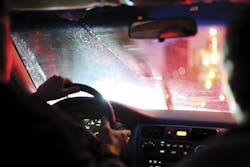”You don’t know what you don’t know” can certainly apply to how too many consumers approach the winter driving season and car maintenance.
For this reason, we contacted Mike Mavrigian, editor of Auto Service Professional, a sister publication to MTD and longtime technical contributor to MTD, to list some glaring misperceptions and explain how you can help educate the consumer and save them from problems during the upcoming winter driving season.
- “My wipers seem OK. Maybe a little streaky, but they get the job done. What’s the big deal about winter?”
Mavrigian: If your customers can’t see clearly, they can’t drive safely. The need for clear visibility is absolutely critical. For winter driving, especially in states that use high levels of salt on the road, dedicated winter blades are a good idea. They use a rubber shield that prevents ice from forming on the wiper arms. If the wiper blades are encrusted with ice, they can’t flex as needed to maintain even contact with the contour of the windshield, causing streaking or a complete lack of contact.
You can also recommend they keep the windshield clean by using an approved cleaner that minimizes the chance for ice from clinging to the glass. It’s a natural add-on sale at the counter. Another tip is to check the windshield washer system and nozzles for operation. If clogged, disconnect the solvent delivery hose from the nozzles and run a fine wire through the nozzle, followed by blowing it clean with compressed air. Also verify that the rubber delivery hose is not clogged, cracked or leaking. Check to make sure that the customer hasn’t filled the windshield solvent tank with water, which can quickly freeze and clog nozzles.
- “My headlight lenses are a bit cloudy, but that comes with old age and I have to just live with it.”
Mavrigian: Make sure the customer knows that there are a number of products today that can clean up the lenses in modern headlights. Since the amount of daylight is short during the winter, it’s critically important for the vehicle to emit as much light as possible. You should find the cleaning/polishing system you like the best and train one of your team to quickly and properly clean the lens. It’s another add-on service that your customers will immediately find beneficial.
- “My car handles fine. Why do my wheel alignment, steering and suspension need to be inspected?”
Mavrigian: As the coefficient of friction is reduced on slippery roads (snow/ice), any wheel misalignment issues will be compounded in terms of vehicle directional stability. For instance, if the vehicle has a slight pull to the left on dry roads, or if the vehicle tends to “wander” a bit on dry roads, this can easily result in a severe and sometimes unexpected pull on slippery road surfaces which can easily result in loss of control. By the same token, the effects of worn steering/suspension components (such as tie rod ends, control arm bushings, work struts/shocks, etc.) will be quickly compounded in slippery road conditions. While the vehicle may seem drivable and manageable in dry conditions, any wheel alignment problems and/or excess play in chassis components will magnify directional control issues on slippery surfaces.
- “Gee, my car’s brakes feel fine. Why should I worry?”
Mavrigian: Although the braking performance may seem “adequate” on dry roads, brake system issues will be compounded as the coefficient of friction is reduced between the road surface and the tires, in addition to subzero temperatures potentially affecting brake performance. If one or more brake calipers has a tendency to stick or hang-up (non-return), while dry road conditions may allow the driver to compensate, slippery road conditions will allow any brake anomalies to cause one or more wheel locations to either not apply sufficient pressure or impose dragging force, which in turn can cause directional loss of control. A refresher for all your technicians on proper brake inspections will go a long way in making sure your company is making the best recommendations to your customers for their safety. Never, ever shortcut on brakes!
- “My exhaust system is fine. It’s not loud, so there’s no problem.”
Mavrigian: Consider that during cold weather conditions, windows are kept up in the fully closed position, effectively sealing the passenger compartment from the elements. If a small exhaust leak is present, even if not readily noticeable from a sound standpoint, the potential for exhaust gasses to enter the passenger compartment cannot be overstated. From a safety standpoint, the exhaust system should be inspected whenever the vehicle enters the service shop.
- “My engine does not overheat, so I don’t need to be concerned.”
Mavrigian: Wrong. Any engine’s cooling system should be flushed and refilled per the automaker’s service interval recommendations in order to keep the system clean. A plugged heater core won’t be of much use when the outside temperature drops.
Be sure to have your technician do a quick check of the cooling system’s overflow tank to make sure the fluid is within the manufacturer’s specs. If there are any signs of anti-freeze around the engine compartment, now’s the time to inform the customer of what you found. I’ve found over the years that an ounce of prevention is critical when it comes to keeping the cooling system functioning properly.
- “My engine runs fine today. Why should I worry about belts and hoses just because winter is approaching?”
Mavrigian: Cooling system hoses and accessory drive belts have a service life. Belts can become worn and cracked as a result of long-term use and age. Starting a cold engine in freezing temperatures can place added strain on a fatigued belt, resulting in belt failure. Cooling system hoses tend to degrade internally over time. Either a belt failure or a burst hose can leave a motorist stranded. In sub-zero temperatures, this can be not only inconvenient but life-threatening as well. Inspect and service all belts and hoses as needed.
- “My engine starts just fine in September. Guess I’m all set for winter.”
Mavrigian: Famous last words! Depending on battery age and condition, the battery may not provide the cranking amps needed when the outside air temperature drops close to or below freezing. Batteries should always be inspected prior to the onset of winter. If marginal, replace. Also, inspect battery terminals and cable connections whenever the vehicle is in the shop. Any evidence of corrosion/crud buildup should be addressed immediately to ensure maximum current flow.
- “What does cold weather have to do with my doors?”
Mavrigian: This is one of my favorites. It’s not uncommon for airborne moisture to freeze between the door-to-body rubber weather stripping, especially after the vehicle has been parked outdoors overnight in freezing temperatures, making it difficult to open one or more doors. Consider applying a film of lubricant/silicone to the rubber to minimize this potential at no charge to your customers. It only takes a few seconds and when you tell them what you’ve done, they’ll be thanking you every time their doors open easily all winter long.
And one final point. In this age of remote power door locks, it’s still important to maintain operation of the mechanical key lock. If remote operation is not possible (due to a failed remote control battery or other electrical issue), maintaining the cleanliness and lubrication of the door lock key passage will provide a backup means of unlocking the door(s). Consider applying lock lube/lock deicer and verify the mechanical key-in-lock operation. ■




